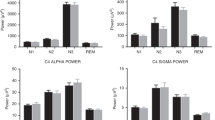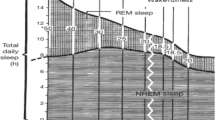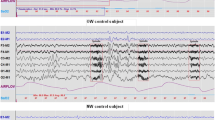Abstract
Objective
To determine the effects of iron-deficiency anemia on the development of non-rapid-eye-movement (NREM) sleep stages, as indexed by sleep spindles.
Study design
Patterns of sleep spindles during NREM sleep stages 2 and 3–4 (slow-wave-sleep, SWS) were compared in 26 otherwise healthy 6-month-old Chilean infants with iron-deficiency anemia and 18 non-anemic control infants. From polygraphic recordings, EEG activity was analyzed for sleep spindles to assess their number (density), duration, frequency, and inter-spindle interval.
Results
Iron-deficient anemic infants differed from the control group by having sleep spindles with reduced density, lower frequency, and longer inter-spindle intervals in NREM sleep stage 2 and SWS.
Conclusions
These results provide evidence of delayed sleep spindle patterns in iron-deficient anemic infants, suggesting that iron is an essential micronutrient for the normal progression of NREM sleep pattern development in the human.
Similar content being viewed by others
References
Youdim MBH, Yehuda S, Ben-Uriah Y (1981) Iron deficiency-induced circadian rhythm reversal of dopaminergic-mediated behaviours and thermoregulation in rats. Eur J Pharmacol 74:295–301
Glover J, Jacobs A (1972) Activity pattern of iron-deficient rats. BMJ 2:627–628
Youdim MBH, Yehuda S (1985) Iron deficiency induces reversal of dopamine dependent circadian cycles: differential response to d-Amphetamine and TRH. Peptides 6:851–855
Youdim MBH (1988) Brain iron: neurochemical and behavioural aspects. Taylor & Francis, London
Beard J, Stoltzfus R (2001) Iron-deficiency anemia: reexamining the nature and magnitude of the public health problem. J Nutr 131:563S–703S
Mannar V, Bellamy C (2004) Vitamin and mineral deficiency – a global progress report. UNICEF, New York
WHO (1998) Global Database on Child Growth and Malnutrition. WHO, Geneva
Administrative Committee on Coordination Sub-Committee on Nutrition (ACC/SCN) (2000) Fourth Report on the World Nutrition Situation. ACC/SCN in collaboration with IFPRI, Geneva
Stoltzfus RJ, Mullany L, Black RE (2004) Iron deficiency anaemia. In: Ezzati M, Lopez AD, Rodgers A, Murray CJL (eds) Comparative quantification of health risks: global and regional burden of disease attributable to selected major risk factors. World Health Organization, Geneva, pp 163–209
Brotanek JM, Halterman J, Auinger P et al (2005) Iron deficiency, prolonged bottle-feeding, and racial/ethnic disparities in young children. Arch Pediatr Adolesc Med 159:1038–1042
Smith LB, Thelen E, Titzer R et al (1999) Knowing in the context of acting: the task dynamics of the A-not-B error. Psychol Bul 106:235–260
Beard JL, Connor JR (2003) Iron status and neural functioning. Ann Rev Nutr 23:41–58
Lozoff B, Georgieff MK (2006) Iron deficiency and brain development. Semen Pediatr Neurol 13:158–165
Roncagliolo M, Garrido M, Walter T et al (1998) Evidence of altered central nervous system development in infants with iron deficiency anemia at 6 mo: delayed maturation of auditory brain stem responses. Am J Clin Nutr 68:683–690
Angulo-Kinzler RM, Peirano P et al (2002) Spontaneous motor activity in human infants with iron-deficiency anemia. Early Hum Dev 66:67–79
Angulo-Kinzler RM, Peirano P, Lin E et al (2002) Twenty-four-hour motor activity in human infants with and without iron deficiency anemia. Early Hum Dev 70:85–101
Fagioli I, Salzarulo P (1982) Sleep states development in the first year of life assessed through 24-h recordings. Early Hum Dev 6:215–228
Coons S, Guilleminault C (1982) The development of sleep-wake patterns and non-rapid eye movement stages during the first six months of life in normal infants. Pediatrics 69:793–798
Louis J, Cannard C, Bastuji H et al (1997) Sleep ontogenesis revisited: a longitudinal 24-h home polygraphic study on 15 normal infants during the first two years of life. Sleep 20:323–333
Steriade M, Deschenes M, Domich L et al (1985) Abolition of spindle oscillations in thalamic neurons disconnected from nucleus reticularis thalami. J Neurophysiol 54:1473–1497
Metcalf DR (1970) EEG sleep spindle ontogenesis. Neuropadiatrie 1:428–433
Curzi-Dascalova L (1977) Waking and sleeping E.E.G. in normal babies before 6 months of age. Revue d’Electroencephalographie et de Neurophysiologie Clinique 7:316–326
Ellingson RJ (1982) Development of sleep spindle bursts during the first year of life. Sleep 5:39–46
Louis J, Zhang JX, Revol M et al (1992) Ontogenesis of nocturnal organization of sleep spindles: a longitudinal study during the first 6 months of life. Electroencephalogr Clin Neurophysiol 83:289–296
Hughes JR (1996) Development of sleep spindles in the first year of life. Clin Electroencephalogr 27:107–115
Monod N, Eliet-Flesher J, Dreyfus-Brisac C (1977) Le sommeil du nouveau-ne et du premature. III. Les troubles de l’organization du sommeil chez le nouveau-ne pathologique: analyse des etudes polygraphiques. Biol Neonatorum 11:216–247
Dreyfus-Brisac C, Curzi-Dascalova L (1975) The EEG during the first year of life. In: Remond A (ed) The evolution of the EEG. Handbook of electroencephalography. Elsevier, Amsterdam, pp 24–30
Shibagaki M, Kiyono S, Watanabe K (1982) Spindle evolution in normal and mentally retarded children: a review. Sleep 5:47–57
Lozoff B, De Andraca I, Castillo M et al (2003) Behavioral and developmental effects of preventing iron-deficiency anemia in healthy full-term infants. Pediatrics 112:846–854
Rechtschaffen A, Kales A (1968) A manual of standardized terminology, techniques and scoring system for sleep stages of human subjects. UCLA Brain Research Institute/Brain Information Services, Los Angeles
Guilleminault C, Souquet M (1979) Sleep states and related pathology. In: Korobkin R, Guilleminault C (eds) Advances in perinatal neurology. Spectrum, New York, pp 415–426
McCullagh P, Nelder JA (1989) Generalized linear models. Chapman and Hall, New York
Lozoff B, Brittenham GM, Viteri FE, Wolf AW, Urrutia JJ (1982) The effects of short-term oral iron therapy on developmental deficits in iron deficient anemic infants. J Pediatr 100:351–357
Lozoff B, Brittenham GM, Wolf AW et al (1987) Iron deficiency anemia and iron therapy: effects on infant developmental test performance. Pediatrics 79:981–995
Lozoff B, Walter T, Kaciroti N (2006) Predicting iron deficiency in infancy: application of a physiologic framework. Am J Clin Nutr 84:1412–1421
Lozoff B (1998) Considering environmental factors in research on nutrient deficiencies and infant development. In: Perman JA, Rey J (eds) Clinical trials in infant nutrition. Lippincott-Raven Publishers, Philadelphia, pp 203–218
Pollitt E (2000) Developmental sequel from early nutritional deficiencies: conclusive and probability judgments. J Nutr 130:350S–353S
Salzarulo P, Fagioli I, Salomon F et al (1982) Developmental trend of quiet sleep is altered by early human malnutrition and recovered by nutritional rehabilitation. Early Hum Dev 7:257–264
Peirano P, Fagioli I, Singh BB et al (1989) Effect of early human malnutrition on waking and sleep organization. Early Hum Dev 20:67–76
Fagioli I, Peirano P, Bes F et al (1989) Sleep in early human malnutrition. In: Horne J (ed) Sleep 88. Gustav Fischer Verlag, Stuttgart, pp 59–62
Peirano P, Fagioli I, Singh BB et al (1990) Quiet sleep and slow wave sleep in malnourished infants. Brain Dysfunct 3:80–83
Fagioli I, Salzarulo P, Salomon F et al (1983) Sinus pauses in early human malnutrition during waking and sleeping. Neuropediatrics 14:43–46
Lenard HG, Schulte FJ (1974) Sleep spindles in hormonal and metabolic diseases of infancy and childhood. In: Petre-Quadens O, Schlag JD (eds) Basic sleep mechanisms. Academic Press, New York, pp 380–403
Gurses D, Kilic I, Sahiner T (2005) The effects of hyperbilirubinemia on sleep-spindle characteristics in infants. Sleep 28:644–648
De Giorgis GF, Nonnis E, Crocioni F et al (1996) Evolution of daytime quiet sleep components in early treated phenylketonuric infants. Brain Dev 18:201–206
De Giorgis GF, Nonnis E, Crocioni F et al (1972) Development of sleep patterns in autistic children. In: Clement C, Purpura DP, Mayer FE (eds) Sleep and the maturing mervous system. Academic Press, New York, pp 321–363
Contreras D, Destexhe A, Sejnowski TJ et al (1996) Control of spatiotemporal coherence of a thalamic oscillation by corticothalamic feedback. Science 274:771–774
Steriade M (1999) Coherent oscillations and short-term plasticity in corticothalamic networks. Trends Neurosci 22:337–345
Beard JL, Wiesinger JA, Connor JR (2003) Pre- and postweaning iron deficiency alters myelination in Sprague-Dawley rats. Dev Neurosci 25:308–315
Larkin EC, Rao GA (1990) Importance of fetal and neonatal iron: Adequacy for normal development of central nervous system. In: Dobbing J (ed) Brain, behaviour, and iron in the infant diet. Springer-Verlag, London, pp 43–62
Kwik-Uribe CL, Gietzen D, German JB et al (2000) Chronic marginal iron intakes during early development in mice result in persistent changes in dopamine metabolism and myelin composition. J Nutr 130:2821–2830
Ortiz E, Pasquini JM, Thompson K et al (2004) Effect of manipulation of iron storage, transport, or availability on myelin composition and brain iron content in three different animal models. J Neurosci Res 77:681–689
Hill JM (1988) The distribution of iron in the brain. In: Youdim MBH (ed) Brain iron: neurochemical and behavioural aspects. Taylor and Francis, London
Carmody DP, Dunn SM, Boddie-Willis AS et al (2004) A quantitative measure of myelination development in infants, using MR images. Neuroradiology 46:781–786
Jorgenson LA, Wobken JD, Georgieff MK (2003) Perinatal iron deficiency alters apical dendritic growth in hippocampal CA1 pyramidal neurons. Dev Neurosci 25:412–420
Schade JP, Meeter K (1963) Neuronal and dendritic patterns in the uncinate area of human hippocampus. Prog Brain Res 3:89–110
Lozoff B, Beard J, Connor J et al (2006) Long-lasting neural and behavioral effects of iron deficiency in infancy. Nutr Rev 64:S34–S43
Beard JL, Felt B, Schallert T et al (2006) Moderate iron deficiency in infancy: biology and behavior in young rats. Beba Brain Res 170:224–232
Felt BT, Beard JL, Schallert T et al (2006) Persistent neurochemical and behavioral abnormalities in adulthood despite early iron supplementation for perinatal iron deficiency anemia in rats. Behav Brain Res 171:261–270
Lanoir J, Ternaux JP, Pons C et al (1981) Long-term effects of a tryptophan-free diet on serotonin metabolism and sleep-waking balance in rats. Exp Brain Res 41:346–357
Hommes FA (1993) The effect of hyperphenylalaninaemia on the muscarinic acetylcholine receptor in the HPH-5 mouse brain. J Inherit Metab Dis 16:962–974
Jenni OG, Borbely AA, Achermann P (2004) Development of the nocturnal sleep electroencephalogram in human infants. Am J Physiol Regul Integr Comp Physiol 286:R528–R538
Rosanova M, Ulrich D (2005) Pattern-specific associative long-term potentiation induced by a sleep spindle-related spike train. J Neurosci 25:9398–9405
Walker MP, Stickgold R (2006) Sleep, memory, and plasticity. Ann Rev Psychol 57:139–166
Schabus M, Gruber G, Parapatics S et al (2004) Sleep spindles and their significance for declarative memory consolidation. Sleep 27:1479–1485
Fogel SM, Smith CT (2006) Learning-dependent changes in sleep spindles and Stage 2 sleep. Sleep 15:250–255
Schabus M, Hodlmoser K, Gruber G et al (2006) Sleep spindle-related activity in the human EEG and its relation to general cognitive and learning abilities. Eur J Neurosci 23:1738–1746
Schmidt C, Peigneux P, Muto V et al (2006) Encoding difficulty promotes postlearning changes in sleep spindle activity during napping. J Neurosci 26:8976–8982
Peirano P, Algarin C, Uauy R (2003) Sleep-wake states and their regulatory mechanisms throughout early human development. J Pediatr 143:S70–S79
Parmelee AH, Sigman M, Garbanati J et al (1994) Neonatal electroencephalographic organization and attention in early adolescence. In: Dawson G, Fischer KW (eds) Human behavior and the developing brain. Guilford, New York, pp 537–554
Grantham-McGregor S, Ani C (2001) A review of studies on the effect of iron deficiency on cognitive development in children. J Nutr 131:649S–668S
Chase MH, Harper RM (1971) Somatomotor and visceromotor correlates of operantly conditioned 12–14 c/sec sensorimotor cortical activity. Electroencephalogr Clin Neurophysiol 31:85–92
Trenkwalder C, Paulus W, Walters AS (2005) The restless legs syndrome. Lancet Neurol 4:465–474
Earley CJ, Heckler D, Allen RP (2004) The treatment of restless legs syndrome with intravenous iron dextran. Sleep Med 5:231–235
Simakajornboon N, Gozal D, Vlasic V et al (2003) Periodic limb movements in sleep and iron status in children. Sleep 26:735–738
Simakajornboon N (2006) Periodic limb movement disorder in children. Paediatr Respir Rev 7:S55–S57
Shinomiya S, Nagata K, Takahashi K et al (1999) Development of sleep spindles in young children and adolescents. Clin Electroencephalogr 30:39–43
De Gennaro L, Ferrara M (2003) Sleep spindles: an overview. Sleep Med Rev 7:423–440
Acknowledgements
The authors thank the infants and parents whose participation made this study possible. We also thank Miriam Dinamarca for valuable assistance, technicians for performing the polysomnographic recordings during the course of this study, drivers for providing careful transportation services to infants and parents, and Yuezhou Jing for statistical support. The work was supported by grants from the U.S. National Institutes of Health (R01 HD14122 and R01 HD33487, Betsy Lozoff, P.I.) and FONDECYT in Chile (1040945, Patricio Peirano, P.I.).
Author information
Authors and Affiliations
Corresponding author
Additional information
Special issue dedicated to Dr. Moussa Youdim.
Rights and permissions
About this article
Cite this article
Peirano, P., Algarín, C., Garrido, M. et al. Iron-Deficiency Anemia is Associated with Altered Characteristics of Sleep Spindles in NREM Sleep in Infancy. Neurochem Res 32, 1665–1672 (2007). https://doi.org/10.1007/s11064-007-9396-8
Received:
Accepted:
Published:
Issue Date:
DOI: https://doi.org/10.1007/s11064-007-9396-8




